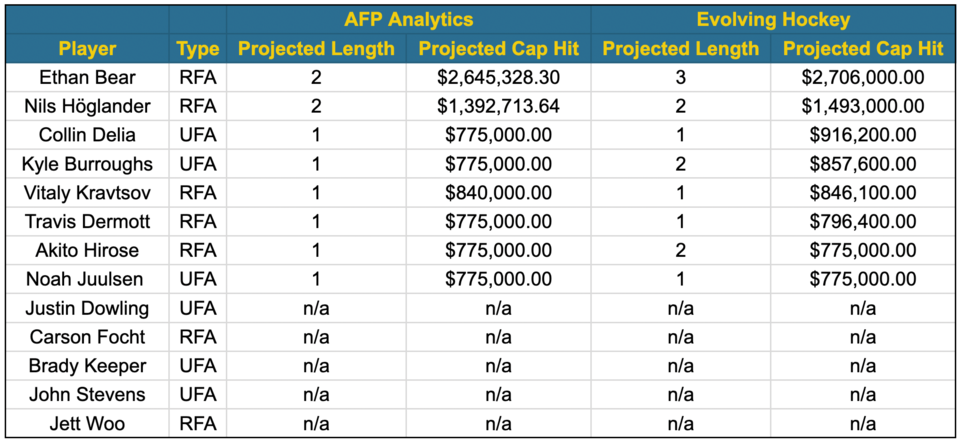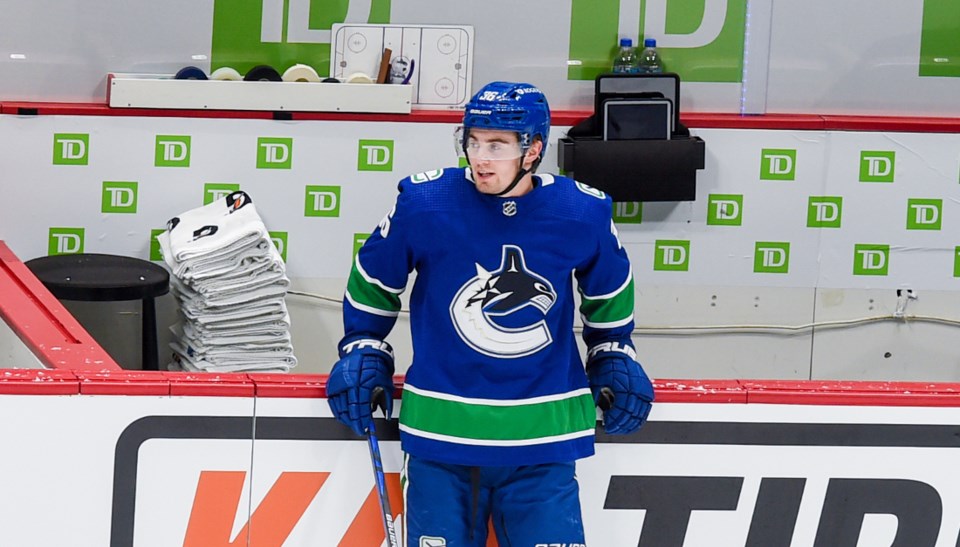The Vancouver Canucks don’t have a lot of cap space available for next season but they also don’t have many players in need of new contracts.
The Canucks currently have 13 pending free agents but that includes AHL players like John Stevens and Brady Keeper, as well as Vitaly Kravtsov, who will be signing in the KHL. They only have a couple of key free agents to re-sign, as well as some decisions to make about fringe players.
For instance, do the Canucks want to re-sign Collin Delia to be Thatcher Demko’s backup next season or do they want to hand that job to Arturs Silovs, who is coming off an MVP performance at the World Hockey Championship? Will Kyle Burroughs return as the team’s seventh defenceman or could that role be filled by someone like Christian Wolanin, who was named the top defenceman in the AHL last season?
The two most important pending free agents are Ethan Bear and Nils Höglander, both of whom will be restricted free agents. But what type of contract might they receive?
Contract projections for the Canucks' free agents
We can get a good idea from their contract projections based on past NHL contracts. Both AFP Analytics and Evolving Hockey have published their projections for pending free agents and they give Canucks fans a good framework for knowing what to expect.

For most of the Canucks’ pending free agents, contracts at or near the league minimum make sense but Bear and Höglander are due a little bit more.
Bear is projected to get a two or three-year deal at around $2.7 million per year. That would buy up one or two years where Bear could be an unrestricted free agent and would fit what similar second-pairing defencemen have signed in the past.
Höglander, however, is an interesting one. It’s unusual for a player to spend two years in the NHL, then spend the majority of the season in the AHL. Both projections predict a two-year deal at around $1.4-1.5 million per year — the type of “show-me contract” that asks a player to prove they can stick in the NHL and play a major role.
But the Canucks have another option with Höglander. They could bet big on him becoming a significant contributor in the coming years and sign him to a long-term deal.
Does a long-term deal make sense for Höglander?
While many players sign a long-term deal immediately after their initial entry-level contract, they’re mostly players who have already established themselves as stars. They’re the types of players that teams can be confident will be a crucial part of their core for years to come.
Höglander’s unique situation, however, gives the Canucks a chance to lock in the young winger at a fixed cap hit for potentially the best years of his career.
Evolving Hockey’s contract projections highlight the most likely contract for a player but they also include projected cap hits for other terms. Höglander’s most likely contract is for two years but what if he were to sign for six, seven, or even eight years?

Why would the Canucks want to sign Höglander to a long-term deal?
Firstly, there’s reason to believe that Höglander can be a very good top-six winger in the NHL. His first season with the Canucks was strong, with 27 points in 56 games and sterling underlying numbers. In his second season, the points dropped off, but his underlying puck possession was still excellent. He was trending toward being a legitimate second-line winger.
Two things were missing from Höglander’s game: defensive details and offensive confidence. To that end, the Canucks sent Höglander down to the AHL, where he worked on both elements to become a better, more well-rounded player.
The Canucks organization as a whole seems confident in Höglander’s progression and, as a player now eligible for waivers, is almost certain to be in the NHL to stay starting next season.
“It was impressive to see [Höglander’s] last two and a half months in Abbotsford,” said general manager Patrik Allvin to Hockey Sverige. “We are really happy with his development and really looking forward to his training camp.”
Höglander will be eligible to become an unrestricted free agent in five years. That’s because when he was sent down to the AHL, it meant the 2022-23 season didn’t count as an “accrued season.”
Höglander is a restricted free agent (RFA), which means the Canucks hold his exclusive negotiating rights. A player doesn’t become a UFA until he has seven accrued seasons or is 27. In order to count as an accrued season, a player has to appear in 40 NHL games or the equivalent if he is injured and still on the roster.
Because Höglander played only 25 NHL games before he was sent down to Abbotsford, Höglander has just two accrued seasons. That means he has five more seasons until he becomes a UFA, at which point he’ll be 27 and would become a UFA no matter what.
The Canucks need to figure out the right way to handle these five years. If the Canucks are confident in Höglander, betting on him with a long-term deal could lead to reaping the benefits against the salary cap for years to come.
The pros and cons of short and long-term deals
The risk with a two-year deal is that Höglander breaks out in those two years and demands a significantly more expensive contract. Even as an RFA, Höglander could be pricey, particularly since he would be eligible for arbitration.
Instead of a two-year deal, the Canucks could aim for a four-year deal with Höglander that would see him still remain an RFA when it expires, with Evolving Hockey projecting a $2.653 million cap hit on that term. That would give the Canucks some cost certainty while also ensuring he stays under team control for at least five more years.
The same issues exist on a four-year deal as with a two-year deal. This type of bridge deal can lead to a significantly more expensive contract in the future. The Canucks have an example of how bridge deals can be costly in Elias Pettersson, who is now due for a significant raise and could walk himself to unrestricted free agency if he doesn't get it.
Where the Canucks could really benefit in a Höglander deal is by buying up one or more UFA years.
Evolving Hockey projects around $3.1 million per year on six or seven-year deals for Höglander and a $3.656 million cap hit on an eight-year deal, though it’s hard to know how accurate those projections may be because players like Höglander don’t typically get long-term deals.
But that’s why it could be so beneficial for the Canucks. Höglander has the potential to become the type of top-six winger that teams pay $5-6 million for on the open market. If he manages that, a cap hit in the $3.1 million range would be a steal.
Most importantly, the Canucks would be paying for what should be the best seasons of Höglander's career, as aging curves show that NHL players typically peak at around the age of 25 and tend to decline sharply after 30. A six or seven-year deal would take Höglander to 28 or 29, paying for his prime years and giving them the option of walking away after.
For Höglander, the benefits of a long-term deal are clear, giving him a lot of security — very welcome after he had to deal with being sent down to the AHL. That type of contract would send a message that the Canucks believe in his future with the team, providing a major confidence boost.
Would a long-term contract be worth the risk? Höglander still has a lot to prove and it’s entirely possible that he tops out as a third-line winger. But if he can become a top-six winger, a long-term deal could pay off.
There is one remaining question: can the Canucks afford it? The team’s current cap situation is tight and a long-term deal that costs twice as much over the next two years might not fit, even if it would provide significant savings long term.




